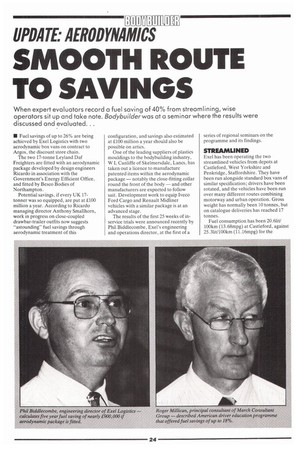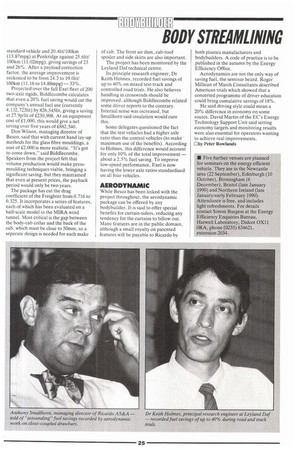SMOOTH ROUTE TO SAVINGS
Page 138

Page 139

If you've noticed an error in this article please click here to report it so we can fix it.
• Fuel savings of up to 26% are being achieved by Exel Logistics with two aerodynamic box vans on contract to Argos, the discount store chain.
The two 17-tonne Leyland Daf Freighters are fitted with an aerodynamic package developed by design engineers Ricardo in association with the Government's Energy Efficient Office, and fitted by Besco Bodies of Northampton.
Potential savings, if every UK 17tanner was so equipped, are put at £100 million a year. According to Ricardo managing director Anthony Smallhom, work in progress on close-coupled drawbar-trailer outfits now suggests "astounding" fuel savings through aerodynamic treatment of this configuration, and savings also estimated at £100 million a year should also be possible on artics.
One of the leading suppliers of plastics mouldings to the bodybuilding industry, W L Cunliffe of Skelmersdale. Lancs, has taken out a licence to manufacture patented items within the aerodynamic package — notably the close-fitting collar round the front of the body — and other manufacturers are expected to follow suit. Development work to equip Iveco Ford Cargo and Renault Midliner vehicles with a similar package is at an advanced stage.
The results of the first 25 weeks of inservice trials were announced recently by Phil Biddlecombe, Exel's engineering and operations director, at the first of a series of regional seminars on the programme and its findings.
Exel has been operating the two streamlined vehicles from depots at Castleford, West Yorkshire and Penkridge, Staffordshire. They have been run alongside standard box vans of similar specification; drivers have been rotated, and the vehicles have been run over many different routes combining motorway and urban operation. Gross weight has normally been 10 tonnes, but on catalogue deliveries has reached 17 tonnes.
Fuel consumption has been 20.61it/ 100km (13.68mpg) at Castleford, against 25.31it/100km (11.16mpg) for the standard vehicle and 20.41it/100km (13.87mpg) at Penkridge against 25.61W 100km (11.02mpg), giving savings of 23 and 26%. After a payload correction factor, the average improvement is reckoned to be from 24.3 to 19.01it/ 100km (11.1610 14.88mpg)— 33%.
Projected over the full Exel fleet of 200 two-axle rigids, Biddlecombe calculates that even a 20% fuel saving would cut the company's annual fuel use (currently 4,132,7231it) by 826,5451it, giving a saving at 27.9p/lit of £230,908. At an equipment cost of £1,000, this would give a net saving over five years of £882,540.
Don Wilson, managing director of Besco, said that with current hand lay-up methods for the glass fibre mouldings, a cost of £2,000 is more realistic. "It's got to come down," said Biddlecombe. Speakers from the project felt that volume production would make pressmoulding techniques viable, bringing a significant saving, but they maintained that even at present prices, the payback period would only be two years.
The package has cut the drag coefficient of the Freighter from 0.716 to 0.325. It incorporates a series of features, each of which has been evaluated on a half-scale model in the MIRA wind tunnel. Most critical is the gap between the body-cab collar and the back of the cab, which must be close to 50mm, so a separate design is needed for each make of cab. The front air dam, cab-roof spoiler and side skirts are also important.
The project has been monitored by the Leyland Daf technical centre.
Its principle research engineer, Dr Keith Holmes, recorded fuel savings of up to 40% on mixed test-track and controlled road trials. He also believes handling in crosswinds should be improved, although Biddlecombe related some driver reports to the contrary. Internal noise was increased, but Smallhorn said insulation would cure this.
Some delegates questioned the fact that the test vehicles had a higher axle ratio than the control vehicles (to make maximum use of the benefits). According to Holmes, this difference would account for only 10% of the total improvement— about a 2.5% fuel saving. To improve low-speed performance, Exel is now having the lower axle ratios standardised on all four vehicles.
While Besco has been linked with the project throughout, the aerodynamic package can be offered by any bodybuilder. It is said to offer special benefits for curtain-siders, reducing any tendency for the curtains to billow out. Many features are in the public domain. although a small royalty on patented features will be payable to Ricardo by both plastics manufacturers and bodybuilders. A code of practice is to be published in the autumn by the Energy Efficiency Office.
Aerodynamics are not the only way of saving fuel, the seminar heard. Roger Millican of March Consultants described American trials which showed that a concerted programme of driver education could bring cumulative savings of 18%.
He said driving style could mean a 20% difference in economy on some routes. David Martin of the EC's Energy Technology Support Unit said setting economy targets and monitoring results were also essential for operators wanting to achieve real improvements.
Dby Peter Rowlands






















































































































































